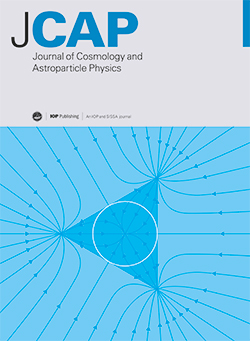A semi-cosmographic approach to study cosmological evolution in phase space
IF 5.9
2区 物理与天体物理
Q1 ASTRONOMY & ASTROPHYSICS
Journal of Cosmology and Astroparticle Physics
Pub Date : 2025-07-09
DOI:10.1088/1475-7516/2025/07/029
引用次数: 0
Abstract
The signature of Baryon Acoustic Oscillation in the clustering of dark-matter tracers allows us to measure (DA(z), H(z)) independently. Treating these as conjugate variables, we are motivated to study cosmological evolution in the phase space of dimensionless variables x = H0DA/c and p = dx/dz. The dynamical variables (x(z),p(z)) can be integrated for a known set of equation of state parameters for different matter/energy components. However, to avoid any preference for specific dark energy models, we adopt a cosmographic approach. We consider two scenarios where the Luminosity distance is expanded as Padé rational approximants using expansion in terms of z and (1 + z)1/2 respectively. However, instead of directly using the Padé ratios to fit kinematic quantities with data, we adopt an alternative approach where the evolution of the cold dark matter sector is incorporated in our analysis through a semi-cosmographic equation of state, which is then, used to solve the dynamical problem in the phase space. The semi-cosmographic (DA(z), H(z)), thus obtained, is fitted with BAO data from DESI DR1, cosmic chronometer (CC) data and SNIa data from Pantheon+ respectively. We also consider a futuristic 21-cm intensity mapping experiment for error projections. We further use the semi-cosmographic fitting to reconstruct some diagnostics of background cosmology and compare our results for the two scenarios of Padé expansions.在相空间中研究宇宙演化的半宇宙学方法
暗物质示踪剂簇中重子声学振荡的特征使我们能够独立测量(DA(z), H(z))。将这些作为共轭变量,我们有动机在无量纲变量x = H0DA/c和p = dx/dz的相空间中研究宇宙演化。动力学变量(x(z),p(z))可以对一组已知的不同物质/能量分量的状态方程参数进行积分。然而,为了避免对特定暗能量模型的偏好,我们采用了宇宙学方法。我们考虑两种场景,其中Luminosity距离分别使用z和(1 + z)1/2展开为pad有理近似。然而,我们没有直接使用pad比率来拟合数据的运动学量,而是采用了另一种方法,即通过半宇宙状态方程将冷暗物质部分的演化纳入我们的分析中,然后使用该方程来解决相空间中的动力学问题。得到的半宇宙线(DA(z), H(z))分别与来自DESI DR1的BAO数据、来自Pantheon+的cosmic chronometer (CC)数据和SNIa数据进行拟合。我们还考虑了一个未来的21厘米强度映射实验,用于误差投影。我们进一步利用半宇宙学拟合重建了一些背景宇宙学的诊断,并比较了我们在两种帕岱尔膨胀情景下的结果。
本文章由计算机程序翻译,如有差异,请以英文原文为准。
求助全文
约1分钟内获得全文
求助全文
来源期刊

Journal of Cosmology and Astroparticle Physics
地学天文-天文与天体物理
CiteScore
10.20
自引率
23.40%
发文量
632
审稿时长
1 months
期刊介绍:
Journal of Cosmology and Astroparticle Physics (JCAP) encompasses theoretical, observational and experimental areas as well as computation and simulation. The journal covers the latest developments in the theory of all fundamental interactions and their cosmological implications (e.g. M-theory and cosmology, brane cosmology). JCAP''s coverage also includes topics such as formation, dynamics and clustering of galaxies, pre-galactic star formation, x-ray astronomy, radio astronomy, gravitational lensing, active galactic nuclei, intergalactic and interstellar matter.
 求助内容:
求助内容: 应助结果提醒方式:
应助结果提醒方式:


